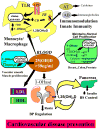The vitamin D deficiency pandemic and consequences for nonskeletal health: mechanisms of action
- PMID: 18801384
- PMCID: PMC2629072
- DOI: 10.1016/j.mam.2008.08.008
The vitamin D deficiency pandemic and consequences for nonskeletal health: mechanisms of action
Abstract
Vitamin D, the sunshine vitamin, is important for childhood bone health. Over the past two decades, it is now recognized that vitamin D not only is important for calcium metabolism and maintenance of bone health throughout life, but also plays an important role in reducing risk of many chronic diseases including type I diabetes, multiple sclerosis, rheumatoid arthritis, deadly cancers, heart disease and infectious diseases. How vitamin D is able to play such an important role in health is based on observation that all tissues and cells in the body have a vitamin D receptor, and, thus, respond to its active form 1,25-dihydroxyvitamin D. However, this did not explain how living at higher latitudes and being at risk of vitamin D deficiency increased risk of these deadly diseases since it was also known that the 1,25-dihydroxyvitamin D levels are normal or even elevated when a person is vitamin D insufficient. Moreover, increased intake of vitamin D or exposure to more sunlight will not induce the kidneys to produce more 1,25-dihydroxyvitamin D. The revelation that the colon, breast, prostate, macrophages and skin among other organs have the enzymatic machinery to produce 1,25-dihydroxyvitamin D provides further insight as to how vitamin D plays such an essential role for overall health and well being. This review will put into perspective many of the new biologic actions of vitamin D and on how 1,25-dihydroxyvitamin D is able to regulate directly or indirectly more than 200 different genes that are responsible for a wide variety of biologic processes.
Figures





References
-
- Abbas S, Linseisen J, Slanger T, Kropp S, Mutschelknauss EJ, Flesch-Janys D, Chang-Claude J. Serum 25-hydroxyvitamin D and risk of post-menopausal breast cancer-results of a large case-control study. Carcinogenesis. 2008;29(1):93–99. - PubMed
-
- Adams JS, Gacad MA, Anders A, Endres DB, Sharma OP. Biochemical indicators of disordered vitamin D and calcium homeostasis in sarcoidosis. Sarcoidosis. 1986;3:1–6. - PubMed
-
- Adams JS, Hewison M. Hypercalcemia caused by granuloma-forming disorders. In: Favus MJ, editor. Primer on the Metabolic Bone Diseases and Disorders of Mineral Metabolism. 6. Washington, DC: American Society for Bone and Mineral Research; 2006. pp. 200–202.
-
- Beer TM, Ryan CW, Venner PM, Petrylak DP, Chatta GS, Ruether JD, Redfern CH, Fehrenbacher L, Saleh MN, Waterhouse DM, Carducci MA, Vacario D, Dreicer R, Higano CS, Ahmann FR, Chi KN, Henner WD, Arroyo A, Clow FW. Double-blinded randomized study of igh-dose calcitriol plus docetaxel compared with placebo plus docetaxel in androgen-independent prostate cancer: a report from the ASCENT investigators. J Clin Oncol. 2007;25:669–674. - PubMed
Publication types
MeSH terms
Grants and funding
LinkOut - more resources
Full Text Sources
Other Literature Sources
Medical
Miscellaneous

